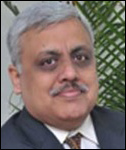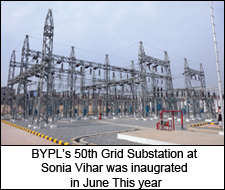 — Ramesh Narayanan, CEO, BSES Yamuna Power Ltd
— Ramesh Narayanan, CEO, BSES Yamuna Power Ltd
Part of Reliance ADA Group, BSES Yamuna Power Ltd took over power distribution in East and Central Delhi from Delhi Vidyut Board in July 2002. The power utility recently celebrated 10 successful years of operation. BYPL has transformed power distribution in its command area from a state of disarray at the time of takeover to a worldclass service today. Ramesh Narayanan takes Venugopal Pillai through those eventful years and asserts that BYPL’s AT&C losses in the coming years would even be lower than internationally-acclaimed standards.
What were the biggest challenges facing BYPL when it took over power distribution of East and Central Delhi in July 2002?
The biggest challenge was to arrest the AT&C losses then ruling at 63.1 per cent. Operationalising our assets was our first concern. Besides this, we emphasised on revamping the entire network and IT-enabling the systems for 100 per cent electrification. Since privatisation, we introduced a number of customer-friendly initiatives and deployed modern technologies, while focusing on our customers.
After 10 years of success what do you consider as the biggest achievements of BYPL?
I would say it is the electrification of all 600 unauthorised colonies leading to 100 per cent electrification of the BYPL area. We reached out to the poorest of the poor with legal connections. We revamped the entire network with state-of-the-art IT enabled systems and with 100 per cent metering. Today, we are emerging as the control centre powering Delhi’s policy makers, media houses, law and order officials. The successful completion of the Commonwealth Games with no power glitches at the venue and CWG village is one of our major achievements. We also supply power to the longest network of the DMRC metro in Delhi.
By providing quality power support to DJB’s water treatment plant at Sonia Vihar and various pumping stations, we have ensured regular water supply to entire Delhi.
You said that ATC losses ruled at over 60 per cent at the time of takeover. What have been the trends in ATC losses over the ten years?
For BYPL, 100 per cent electrification and metering at input and output points has helped us bring down our AT&C losses.
BYPL has set a world record in reducing the AT&C loss by over 45 per cent in last 10 years. In next few years, we are targeting to bring the loss level to even below that of developed European countries. AT&C levels of US are 7.6 per cent, while in UK it is 8.2 per cent and Japan, 5 per cent.
At present BYPL’s loss level is around 17.8 per cent. Hopefully, by next year Russia with current loss levels of 14.8 per cent will be trailing us.
 How has the peak demand grown in the East and Central Delhi region? Does BYPL’s command area face peak demand shortages?
How has the peak demand grown in the East and Central Delhi region? Does BYPL’s command area face peak demand shortages?
In Delhi, peak demand met has almost doubled from 2,879 MW to 5,642 mw over the past decade. Since privatisation, we have also enhanced our distribution network to proportionately meet the increased demand from 798 MW in 2002 to 1,461 mw in 2012.
Due to proper planning, we have successfully provided power to our 12.3 lakh customers consistently without facing any shortages.
Tell us how commercial losses in the form of power theft, unmetered connections, “free power” and under-recoveries are being controlled by BYPL.
It is through electrification and metering at each and every point. We, at BYPL, revamped the outdated, outlived and dilapidated network into a state-of-the-art network. Deployment of technology helped identify and close any such gaps. Regular energy audits, billing through SAP, control through SCADA, GIS etc. are the few initiatives we have undertaken.
Privatisation of power distribution despite bringing techno-commercial efficiency has not taken off in a big way in India.
In India, there is no dearth of politicians. But there are very few leaders with the political will for sustained development. Hence, the sector reforms are delayed in many states.
Is lack of political will the biggest hindrance?
I agree. In fact, an all-India dip-stick survey was taken today, an overwhelming number would vote for PPPs in power distribution for better management, apart from responsive and reliable power supply.
Please discuss the preparedness of BYPL in moving towards Smart Grid, or a Smart Grid-like situation, in future.
We are at an advanced stage of preparedness. I believe that there are 5 basic pillars for a Smart Grid. There are electronic records and billing through SAP-ISU, SAP ERP. Then there is GIS, SCADA, DMS (Distribution Management System) and AMI (Advanced Metering Infrastructure). We have successfully implemented the first four.
Since the specifications for smart meter are still being developed, thus the power distribution utilities are conducting pilots to test the efficacy of the same.
Please summarise key goals that BYPL would like to attain in the next five years.
We are gearing up to meet the proportionate power demand of over 8,000 MW in 2017 (as per CEA’s Electric Power Survey of India) and 12,000 MW (as per draft of Delhi master plan) by 2020.
Apart from that, we at BYPL, plan not only to implement many initiatives to reduce the loss levels at par with developed countries but also to provide the best of services and infrastructure to our customers.
Our endeavour has always been to introduce technology which will define the modern utility approach in the sector. We aim to be the fountainhead to promote best resources, processes and management approached for the utility sector in the country in particular and world in general.











